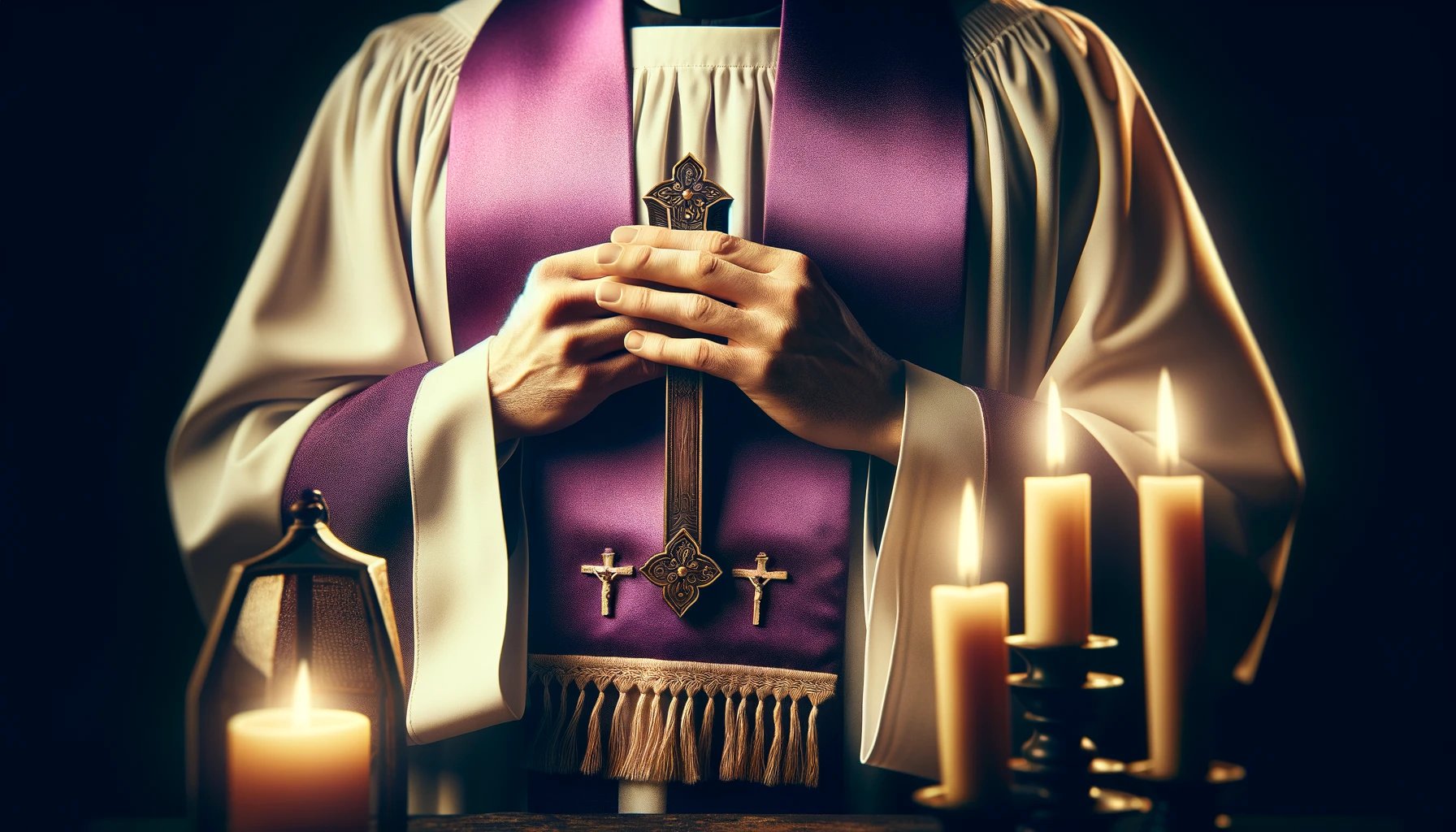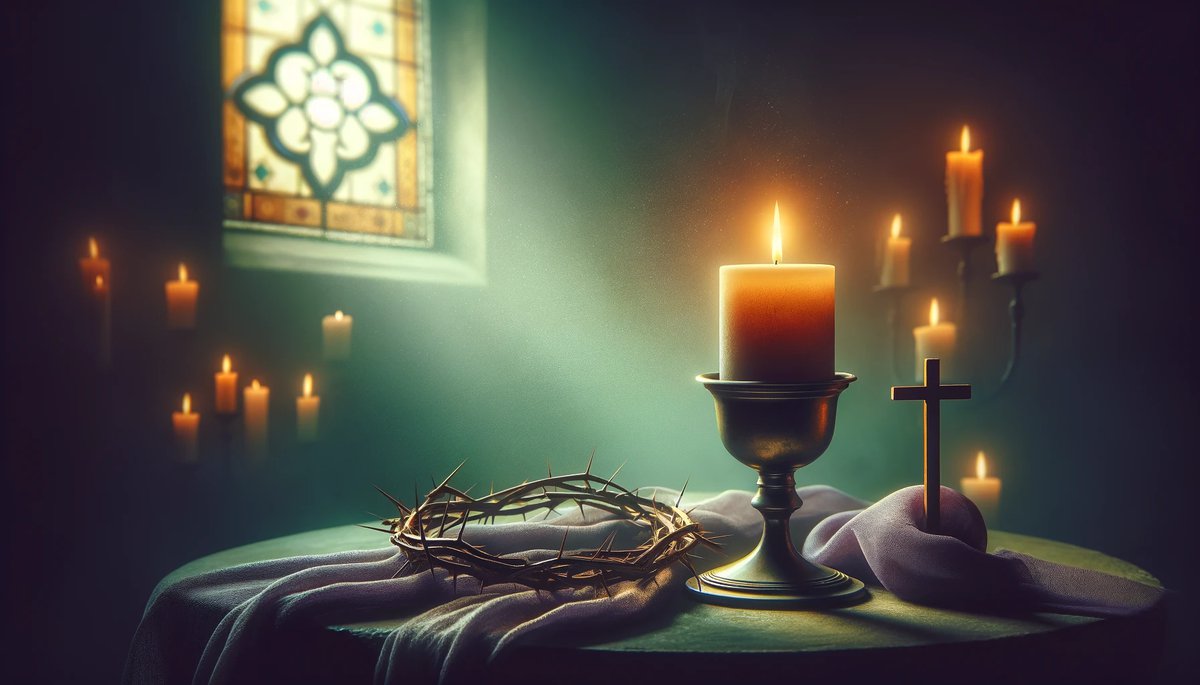Home>Special Themes>What Prayer Of Mass Is Omitted During Lent


Special Themes
What Prayer Of Mass Is Omitted During Lent
Published: February 27, 2024
Jason DeRose, Managing Editor at Christian.net, uses his expertise in religion and journalism to deepen understanding of faith's societal impacts. His editorial leadership, coupled with a strong academic background, enriches the platform’s diverse content, earning him recognition in both journalism and religious circles.
Discover which prayer of the Mass is omitted during Lent and learn about the special themes observed during this season. Explore the significance of Lenten practices and traditions.
(Many of the links in this article redirect to a specific reviewed product. Your purchase of these products through affiliate links helps to generate commission for Christian.net, at no extra cost. Learn more)
Table of Contents
Introduction
Have you ever wondered what changes occur in the Catholic Mass during the season of Lent? Lent is a significant period in the Catholic Church, marked by reflection, repentance, and preparation for Easter. During this time, there are specific alterations made to the Mass to align with the solemnity and introspective nature of the Lenten season. One of the key changes involves the omission of a particular prayer. In this article, we will explore the prayer of the Mass that is omitted during Lent and delve into the significance of this omission in the context of the Catholic faith.
Read more: What Prayer Is Omitted During Lent
The Importance of Lent in the Catholic Church
-
Spiritual Preparation: Lent is a time of spiritual preparation, where Catholics are called to reflect on their lives, repent for their sins, and renew their commitment to their faith. It is a period of self-examination and spiritual growth, leading up to the celebration of Easter.
-
Symbolism of 40 Days: The 40-day duration of Lent is symbolic of Jesus' 40 days of fasting in the desert, where he faced temptation and overcame it. This period serves as a reminder of the sacrifices and challenges that Jesus endured, emphasizing the importance of self-discipline and perseverance in the face of adversity.
-
Focus on Prayer and Almsgiving: Lent encourages Catholics to deepen their prayer life and engage in acts of charity and almsgiving. It is a time to reevaluate priorities, detach from worldly distractions, and focus on nurturing a closer relationship with God and serving others in need.
-
Preparation for Easter: Lent prepares the faithful for the celebration of Easter, the most significant event in the Christian calendar. By engaging in fasting, prayer, and acts of penance, Catholics seek to align their hearts and minds with the profound significance of Christ's resurrection.
-
Renewal and Transformation: Through the observance of Lent, Catholics seek renewal and transformation, aiming to emerge from this period spiritually rejuvenated and strengthened in their faith. It is a time to let go of old habits, seek reconciliation, and embrace a renewed sense of purpose and commitment to living a life in accordance with the teachings of Christ.
-
Communal Reflection and Solidarity: Lent is also a time for communal reflection and solidarity within the Catholic community. It provides an opportunity for believers to come together in prayer, support one another in their spiritual journeys, and collectively strive for personal and communal growth.
Lent holds immense significance in the Catholic Church, serving as a period of introspection, spiritual renewal, and preparation for the joyous celebration of Easter. The observance of Lent encompasses various practices and traditions that foster a deeper connection to faith and a renewed commitment to living a life guided by the principles of Christianity.
Understanding the Structure of the Mass
The Catholic Mass follows a structured format that encompasses various elements, each holding its own significance and purpose within the liturgical celebration. Understanding the structure of the Mass provides insight into the flow of the ritual and the essential components that contribute to the worship experience for the faithful. The Mass is divided into two main parts: the Liturgy of the Word and the Liturgy of the Eucharist. Each part consists of specific prayers, readings, and rituals that collectively form the rich tapestry of the Catholic worship experience.
The Liturgy of the Word
- Opening Rites: The Mass commences with introductory rites, including the Sign of the Cross, the Penitential Act, the Kyrie (Lord, have mercy), and the Gloria (omitted during Lent).
- Liturgy of the Word: This segment features readings from the Old Testament, the Psalms, the New Testament (including a Gospel reading), and a homily or sermon by the priest, offering insights into the scriptural passages and their relevance to contemporary life.
- Prayer of the Faithful: Also known as the General Intercessions, this is a series of petitions for the Church, the world, those in need, and the local community. It is a moment of communal prayer, where the faithful lift up their intentions and concerns to God.
The Liturgy of the Eucharist
- Preparation of the Gifts: The presentation of the bread and wine, which will be consecrated and transformed into the body and blood of Christ during the Eucharistic prayer.
- Eucharistic Prayer: The central prayer of the Mass, where the celebrant offers thanksgiving and consecrates the bread and wine, invoking the Holy Spirit to transform them into the body and blood of Christ.
- Communion Rite: The distribution and reception of the Eucharist, the body and blood of Christ, by the congregation, symbolizing their unity with Christ and with one another.
- Concluding Rites: The Mass concludes with final blessings, the dismissal, and a sending forth to live out the graces received through the Eucharistic celebration.
Understanding the structure of the Mass provides a deeper appreciation for the various components that comprise the liturgical worship of the Catholic Church. Each element contributes to the cohesive and meaningful expression of faith, guiding the faithful through a journey of prayer, reflection, and communion with the divine.
Read more: What Is Omitted From Mass During Advent
The Prayer of the Faithful
The Prayer of the Faithful, also known as the General Intercessions, holds a significant place within the structure of the Catholic Mass. This solemn and communal prayer allows the faithful to lift up their intentions, supplications, and intercessions to God, seeking His guidance, mercy, and grace for the Church, the world, and those in need. The Prayer of the Faithful typically follows the readings and the homily, serving as a pivotal moment for the congregation to unite in prayer and solidarity.
Purpose and Format
The Prayer of the Faithful is characterized by its inclusive nature, encompassing a series of petitions that address various aspects of human life and the broader community. The petitions are typically led by a designated minister or lector, with the congregation responding to each petition with a collective affirmation, such as "Lord, hear our prayer." The format of the intercessions reflects the universal and communal nature of the Church, acknowledging the interconnectedness of humanity and the shared responsibility to pray for one another.
Themes and Intentions
The petitions presented during the Prayer of the Faithful cover a wide range of themes, including prayers for the Church, world leaders, the local community, those experiencing hardship or illness, the deceased, and other specific intentions relevant to the liturgical season or current events. The intercessions are crafted to reflect the universal concerns and challenges faced by individuals and communities, fostering a sense of empathy, compassion, and solidarity among the faithful.
Connection to the Liturgical Calendar
During the season of Lent, the petitions within the Prayer of the Faithful may emphasize themes of repentance, reconciliation, and spiritual renewal, aligning with the overarching focus of the Lenten season. The intercessions may highlight the call to turn away from sin, seek reconciliation with God and one another, and extend acts of charity and compassion to those in need. The Lenten Prayer of the Faithful serves as a poignant reminder of the transformative journey undertaken during this solemn period of reflection and preparation.
Read more: Why Is Prayer Important During Lent
Communal Participation and Response
The Prayer of the Faithful invites active participation from the congregation, encouraging the faithful to engage in collective prayer and express their shared concerns and hopes. Through their responses and silent intentions, the faithful contribute to the communal tapestry of intercession, reinforcing the bonds of unity and mutual support within the Church. The collective voice of the faithful resonates through the intercessions, embodying the spirit of solidarity and shared responsibility for the welfare of all.
Spiritual Significance
The Prayer of the Faithful holds profound spiritual significance, serving as a tangible expression of the Church's mission to bear one another's burdens and uphold one another in prayer. It embodies the scriptural exhortation to "pray without ceasing," reflecting the enduring commitment of the faithful to intercede for the needs of the world and seek God's mercy and guidance. The communal nature of the intercessions underscores the interconnectedness of humanity and the shared journey of faith undertaken by the Church.
In essence, the Prayer of the Faithful stands as a testament to the collective strength of the Church, as the faithful join their hearts and voices in supplication, seeking God's compassion and intervention for the well-being of all.
The Penitential Act
The Penitential Act holds a pivotal place within the introductory rites of the Catholic Mass, serving as a solemn moment of communal repentance and acknowledgment of the need for God's mercy and forgiveness. This act of contrition underscores the significance of self-examination and reconciliation as essential elements of the Catholic faith, particularly during the season of Lent. The Penitential Act comprises three forms, each emphasizing the communal and personal dimensions of seeking reconciliation with God and one another.
Form One: Confiteor
The first form of the Penitential Act, known as the Confiteor, involves the congregation collectively acknowledging their sins and expressing contrition before God. The priest or the deacon leads the assembly in reciting a prayer that begins with "I confess to almighty God" or "We confess to almighty God," followed by a confession of sins and a plea for mercy. This form of the Penitential Act underscores the communal nature of sin and the shared responsibility for seeking forgiveness and reconciliation within the faith community.
Read more: What Is Almsgiving During Lent?
Form Two: Kyrie Eleison
The second form of the Penitential Act, known as the Kyrie Eleison (Lord, have mercy), centers on the invocation of God's mercy and compassion. The congregation, led by the celebrant, engages in a litany of petitions, alternating between the Kyrie Eleison and Christe Eleison (Christ, have mercy), expressing the collective plea for divine mercy and forgiveness. This form of the Penitential Act emphasizes the universal need for God's mercy and the acknowledgment of human frailty and dependence on His grace.
Form Three: Alternative Penitential Rite
The third form of the Penitential Act offers an alternative penitential rite, providing flexibility in the expression of contrition and the acknowledgment of sin. This form may involve the recitation of a prescribed prayer or the adaptation of specific invocations that reflect the penitential character of the season. The alternative penitential rite allows for contextual relevance and pastoral sensitivity, enabling the congregation to engage in a meaningful act of contrition that resonates with the themes of repentance and reconciliation.
The Penitential Act serves as a poignant reminder of the human condition and the universal need for God's mercy and forgiveness. During the season of Lent, this act of contrition takes on added significance, as the faithful engage in a period of introspection and repentance, seeking to reconcile with God and one another. The Penitential Act embodies the spirit of humility, contrition, and the unwavering hope for reconciliation and renewal, aligning with the profound themes of Lent and the transformative journey toward Easter.
The Gloria
The Gloria, also known as the Greater Doxology, is a hymn of praise and adoration that holds a central place within the Catholic Mass. This ancient hymn, rooted in the rich tradition of Christian worship, exalts the glory of God and celebrates the redemptive work of Christ. The inclusion of the Gloria in the liturgy signifies a moment of joyful exultation and reverence, inviting the faithful to unite in proclaiming the greatness of God and expressing gratitude for His mercy and grace.
Scriptural Foundation
The text of the Gloria draws inspiration from various passages of the Bible, particularly the angelic hymn sung at the birth of Jesus in the Gospel of Luke (Luke 2:14). The hymn echoes the angelic proclamation of "Glory to God in the highest, and on earth peace among those with whom he is pleased," encapsulating the jubilant praise offered to God for the gift of salvation through His Son, Jesus Christ. The Gloria weaves together elements of praise, adoration, and thanksgiving, reflecting the scriptural themes of divine glory and the fulfillment of God's promises through Christ.
Read more: What Is Penance During Lent
Liturgical Placement
The Gloria is typically recited or sung immediately after the Penitential Act and the Kyrie Eleison, forming an integral part of the introductory rites of the Mass. Its placement within the liturgy signifies the transition from the solemn act of contrition and supplication for mercy to a moment of exuberant praise and thanksgiving. The Gloria serves as a resounding declaration of the Church's joy and adoration, setting the tone for the celebration of the Eucharist and the proclamation of the Word.
Themes and Structure
The text of the Gloria encompasses themes of praise, adoration, and the redemptive work of Christ. It is structured as a hymn of acclamation, beginning with the exultant words, "Glory to God in the highest," and continuing with expressions of adoration for the divine majesty and the Lamb of God who takes away the sins of the world. The hymn culminates in a fervent plea for God's mercy and the affirmation of His enduring love and faithfulness. The structure of the Gloria reflects the Church's profound reverence for the Triune God and the salvific mission of Jesus Christ, encapsulating the essence of Christian worship and devotion.
Omission During Lent
During the season of Lent, the Gloria is omitted from the Mass, except on solemnities and feasts, as a sign of the Church's solemn observance of this penitential period. The omission of the Gloria during Lent underscores the somber and introspective nature of the season, emphasizing the call to repentance, self-denial, and spiritual renewal. This intentional omission serves as a poignant reminder of the sacrificial journey of Lent, leading the faithful to focus on the themes of humility, contrition, and the anticipation of Christ's redemptive sacrifice on the cross.
Symbolism and Anticipation
The absence of the Gloria during Lent carries profound symbolic significance, evoking a sense of longing and anticipation for the joyous celebration of Easter. Its omission underscores the temporary veiling of exultant praise, as the Church enters into a period of spiritual preparation and contemplation of the Paschal mystery. The silence of the Gloria during Lent serves as a prelude to the exultant proclamation of Christ's resurrection on Easter Sunday, heightening the sense of anticipation and the eventual outpouring of jubilant praise at the culmination of the Lenten journey.
In essence, the Gloria stands as a testament to the Church's exuberant praise and adoration of God, embodying the spirit of joyful worship and gratitude for the redemptive work of Christ. Its omission during Lent serves as a poignant expression of the Church's solemn observance of this sacred season, leading the faithful on a transformative journey of repentance, anticipation, and ultimate rejoicing in the resurrection of Christ.
Read more: What Are The Rules Of Fasting During Lent
Conclusion
In conclusion, the season of Lent holds profound significance within the Catholic Church, guiding the faithful through a period of introspection, repentance, and spiritual renewal. The alterations made to the structure of the Mass during Lent, including the omission of the Gloria, serve as poignant reminders of the solemn and penitential nature of this sacred season. The Prayer of the Faithful, with its communal intercessions, and the Penitential Act, with its expressions of contrition, embody the spirit of repentance and solidarity within the faith community. As the faithful journey through Lent, these adaptations in the Mass provide opportunities for deeper reflection, communal prayer, and a renewed commitment to living out the principles of faith. The omission of the Gloria during Lent underscores the Church's intentional focus on humility, anticipation, and the eventual celebration of Christ's resurrection on Easter. Ultimately, the adaptations in the Mass during Lent serve to enrich the spiritual experience of the faithful, leading them on a transformative journey toward the joyous celebration of Easter.










